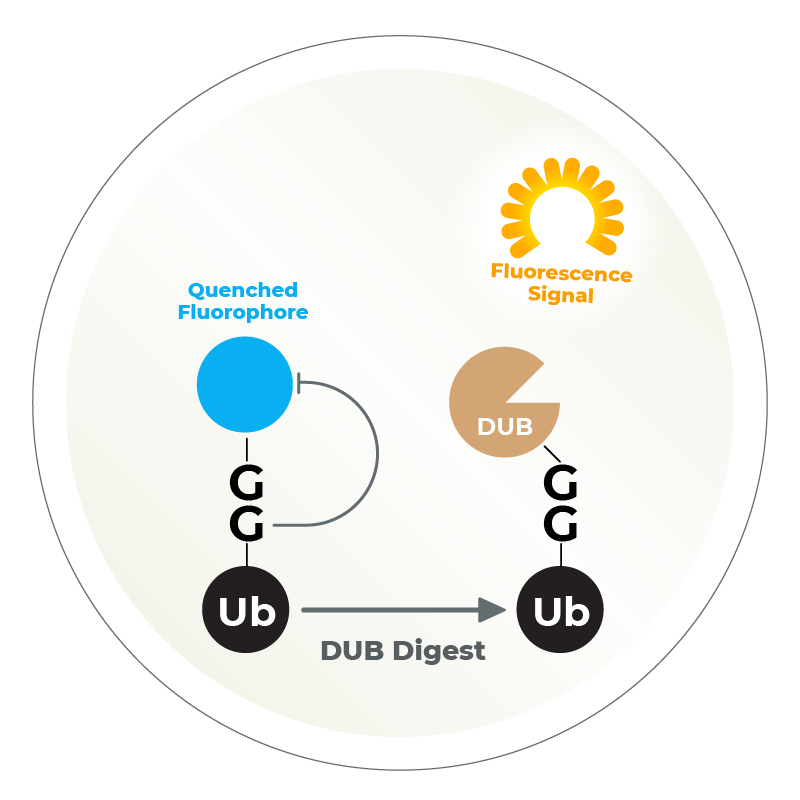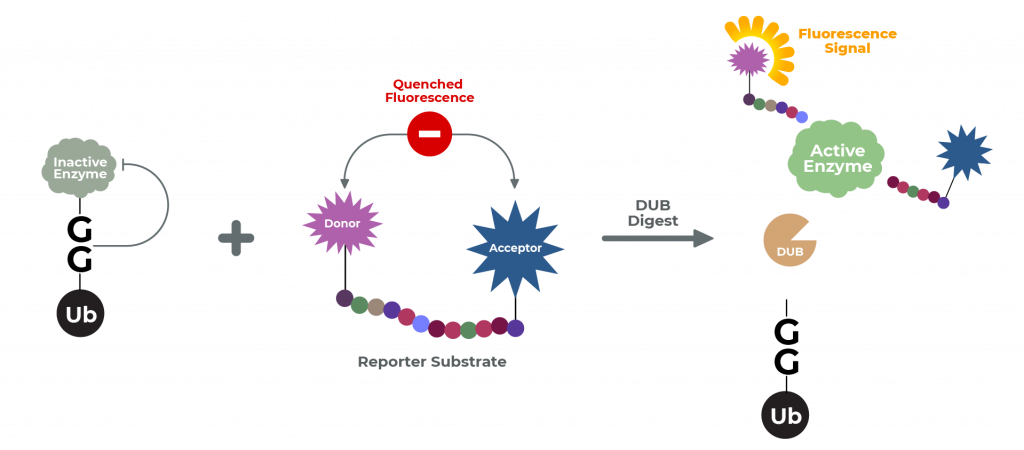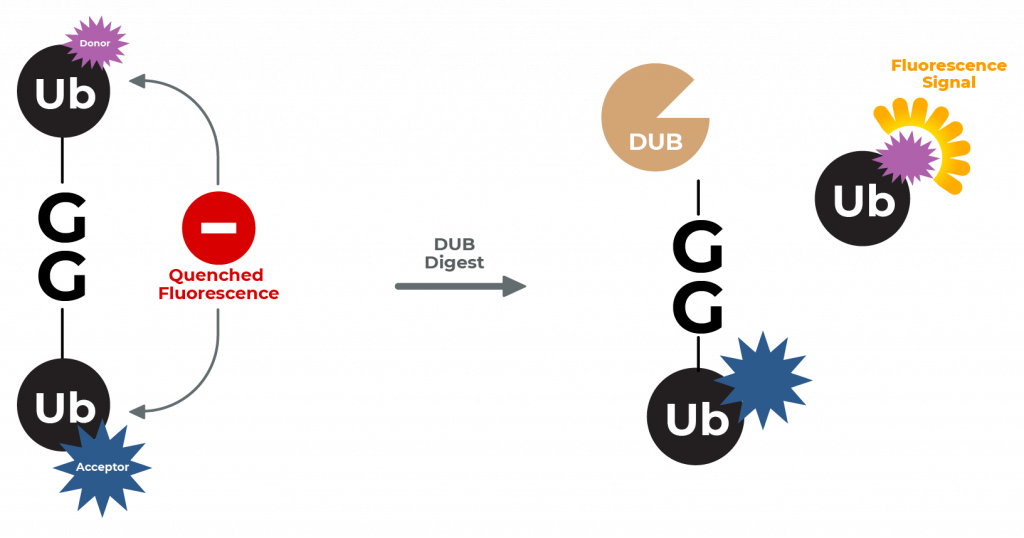DUB Assays, Screening & Profiling
Deubiquitylases (DUBs) are enzymes that can reverse the effect of E3 ligases by removing the ubiquitin from the target proteins. Unlike most E3 ligases, DUBs have inherent catalytic activity that is easily targeted by small molecules. These same DUBs are involved in ubiquitination maturation, recycling, and editing. There are over 100 DUBs that can be divided into seven subfamilies, all capable of being encoded by the human genome. These DUBs have been implicated in many regulatory mechanisms, and biological functions, where they play a role in a plethora of clinical diseases. Here at Lifesensors, we offer you products, technology, and services that help you study DUBs through our DUB assay platform.
Lifesensors has developed a variety of novel fluorescent-based DUB assays, utilizing physiological substrates and polyubiquitin isopeptide-selective substrates. The C-terminus of ubiquitin is tagged with a quenched fluorogenic substrate upon cleavage by the DUB, thus reporting DUB activity. We are proudly the only company that has a wide variety of tools with patented assay platforms that can characterize DUB inhibitor compounds and demonstrate selectivity using carefully curated DUB selectivity panels. We have expressed and purified 35+ DUBs that are validated in HTS and compound profiling. We have established DUB-centric compound libraries to provide standards for monitoring the inhibition of your compounds. Additionally, you will find we offer products and services with di-, tri-, and tetra- ubiquitin chains of different linkages tailored for your studies, along with DUB resistant poly ubiquitin chains to investigate binding interactions.
Learn More About Our DUBs Screening & Profiling Platform Here

Ubiquitin Fluorophore Assay (Rhodamine, AMC, VME)
The ubiquitin fluorophore assay utilizes a ubiquitin molecule bound to a quenched fluorophore (such as Ub-Rhodamine, Ub-AMC, or Ub-VME listed below). After the DUB digestion takes place, the fluorophore is released and fluoresces, which is detected via a plate reader. This is the simplest and most straight forward high throughput assay to measure DUB activity. Ubiquitin Rhodamine (Ub-Rho) is a quenched, fluorescent substrate for DUBs, especially ubiquitin C-terminal hydrolases. Cleavage of the amide bond between the C-terminal glycine of ubiquitin and rhodamine results in an increase in rhodamine fluorescence at 535 nm (Exc. 485 nm).
Lifesensors has a multitude of various fluorescent substrates and DUBs to be used in these assays. These DUB assays utilize physiological substrates, polyubiquitin isopeptide chain-selective substrates, and several proteins attached to the C-terminus of ubiquitin that report a fluorogenic signal upon cleavage by DUBs. These substrates make up a large suite of assay technologies available to our customers. No other company provides such a wide variety of tools for HTS and physiological assays for characterizing compounds and establishing a selectivity panel. LifeSensors has expressed, purified, and characterized ~35 DUBs for HTS and compound profiling and has established DUB-centric compound libraries to provide standards for monitoring the inhibition of your compound or characterizing your DUB.
Service Highlights
- High throughput screening for modulators of DUB activity.
- Determining activity and specificity of isopetidases for Ub/UBL-proteins
- In vitro detection of ubiquitin conjugation, determination of the activity of ubiquitin conjugating enzymes.

CHOP Assay- Ubiquitin, SUMO, ISG15 & NEDD8 (Patented)
Service Highlights
- Superior to Ub-AMC and FRET-based assays
- Rapid and robust readout for DUB activity with 45 minutes and reporter substrates are non-radioactive.
- Amenable to high throughput screening (HTS) and miniaturization, and assay tests deconjugation of ubiquitin/UBL from a more physiological relevant protein.
- Unlike Ub-AMC, the CHOP2-Reporter system does not require excitation in the UV range (reducing the incidence of false-positives).
Di-Ubiquitin IQF Assay (Patented)

LifeSensors’ di-ubiquitin substrates represent a new class of substrates for the continuous fluorescent measurement of true isopeptidase activity. The IQF assay service utilizes a pair of conjugated ubiquitin proteins where one ubiquitin carries the fluorophore silenced by the nearby quencher present on the adjacent ubiquitin. After DUB digestion, the quencher is cleaved from the Di-Ub and the fluorophore is now free to fluoresce and can be detected by a plate reader. This assay is physiologically relevant since the DUB cleaves a Ub-Ub bond! The assays are designed to study DUBs that interact with -K48, -K63 and -K6 linked di-ubiquitin. C-terminus of wild type ubiquitin is conjugated via an isopeptide bond to lysine 48 (K48) of a second ubiquitin molecule with the resultant diubiquitin forming an internally quenched fluorescent FRET pair (IQF).
There are multiple IQF Di-Ub variants that all have remarkable differences. In the case of K48- and K63- their 3D structure varies and can be used to measure various DUBs. For this reason, Lifesensors has created subpanels of IQF Di-Ub substrates with each linkage. Because each DUB is likely to recognize and cleave substrates with unique steric considerations, these subpanels vary in location of reporter fluorophore and quencher.
Our DUB screening assays include assay development where we empirically evaluate activity of DUB against the panel of IQF DiUb substrates to select the optimal fluorophore/quencher pairing.
Service Highlights
- Superior to Ub-AMC and FRET-based assays
- Rapid and robust readout for DUB activity with 45 minutes and reporter substrates are non-radioactive.
- Amenable to high throughput screening (HTS) and miniaturization, and assay tests deconjugation of ubiquitin/UBL from a more physiological relevant protein.
- Unlike Ub-AMC, the CHOP2-Reporter system does not require excitation in the UV range (reducing the incidence of false-positives).
